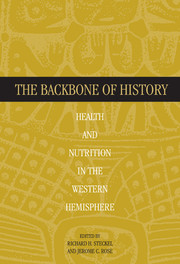Book contents
- Frontmatter
- Contents
- Preface
- List of Contributors
- PART I
- 1 Introduction
- PART II METHODOLOGY
- PART III EURO-AMERICANS AND AFRICAN-AMERICANS IN NORTH AMERICA
- PART IV NATIVE AMERICANS IN CENTRAL AMERICA
- PART V NATIVE AMERICANS AND EURO-AMERICANS IN SOUTH AMERICA
- PART VI NATIVE AMERICANS IN NORTH AMERICA
- PART VII
- PART VIII
- PART IX EPILOGUE
- Index
1 - Introduction
Published online by Cambridge University Press: 01 March 2010
- Frontmatter
- Contents
- Preface
- List of Contributors
- PART I
- 1 Introduction
- PART II METHODOLOGY
- PART III EURO-AMERICANS AND AFRICAN-AMERICANS IN NORTH AMERICA
- PART IV NATIVE AMERICANS IN CENTRAL AMERICA
- PART V NATIVE AMERICANS AND EURO-AMERICANS IN SOUTH AMERICA
- PART VI NATIVE AMERICANS IN NORTH AMERICA
- PART VII
- PART VIII
- PART IX EPILOGUE
- Index
Summary
Human biologists, historians, and other social scientists have expressed enduring interest in the evolution of human health over the past several millennia. The search for knowledge is propelled in part by intellectual curiosity. For the same reasons that explorers of the early twentieth century strove to reach the poles and the highest peaks, and their modern counterparts journey to outer space or deep into the oceans, most humans are inquisitive about their past. They want to understand how they evolved and how they shaped and adapted to their environments. They want to visualize or imagine the contours of the human experience the peaks of adaptive success that led to human growth, expansion, and flowering of civilization, and the valleys of despair in which human presence ebbed and retreated.
But more practical considerations also lead the quest for knowledge. Not only a basic ingredient in the quality of life, health is intertwined with demographic, social, economic, and political change and with the outcomes of wars and other conflicts. Length of life and other aspects of health affect work capacity and the incentives to invest in skills that contribute to economic growth. Basic indicators of the standard of living, such as the human development index proposed by the United Nations, have a substantial health component(UNDP, 1990).Historians and political scientists have identified inequality, not only in income or wealth, but also in the form of disparities in health and nutrition, as a driving force in social, political, and economic change. Thus, health has played a central role in human history, both as an agent of change and as an outcome measure indicating the quality of life.
- Type
- Chapter
- Information
- The Backbone of HistoryHealth and Nutrition in the Western Hemisphere, pp. 3 - 8Publisher: Cambridge University PressPrint publication year: 2002
- 3
- Cited by



